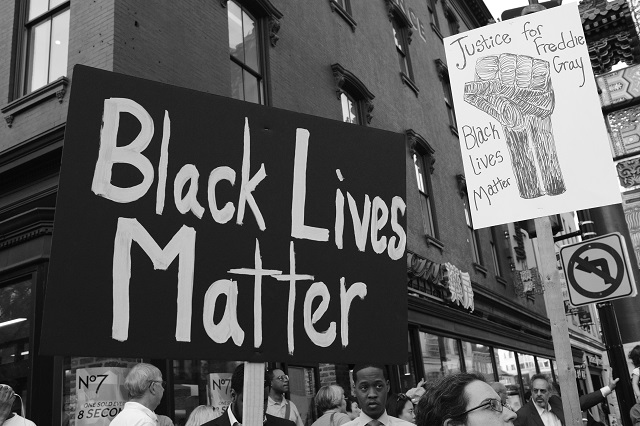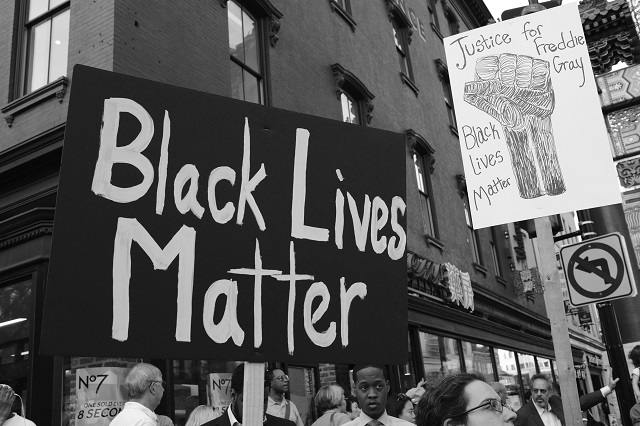
 Stephen Melkisethian / Flickr)” width=”640″ style=”width: 100%;” />(Photo: Stephen Melkisethian / Flickr)
Stephen Melkisethian / Flickr)” width=”640″ style=”width: 100%;” />(Photo: Stephen Melkisethian / Flickr)Keeanga-Yamahtta Taylor has written the most important book of 2016. Published by Haymarket, From #BlackLivesMatter to Black Liberation has struck a chord nationwide, garnering major awards but more importantly sparking necessary debates. Like all militant texts, it walks the fine line between Marx’s “ruthless critique of everything existing” — in this case, not only the white supremacist power structure, but also the abject failure of Black elites and the Obama “illusion” — and the revolutionary optimism coalescing in the streets from Ferguson to Baltimore and beyond. By showing us how we got here, to a society in which “colorblind” rhetoric provides cover for not only racist continuity but also the dispossession of the poor as a whole, Taylor’s book is a compass for charting a different course altogether. George Ciccariello-Maher interviews her for ROAR Magazine.
George Ciccariello-Maher: The introduction to your book — Black Awakening in Obama’s America — is a reference to Robert Allen’s 1969 classic Black Awakening in Capitalist America, which in its attentiveness to the complex interplay of race and class arguably represents a predecessor to your own book. To what extent do you see your work as a sequel to Allen’s analysis of a prior generation’s struggle?
Keeanga-Yamahtta Taylor: Allen captured the way that the Black movement had the capacity to shake the American state to its core. The Black Awakening was not just an issue for Black people — it was a threat to the system itself. And the system reacted accordingly. Allen pays particular attention to the repeated attempts of capital to absorb, usurp and in some cases coopt the Black movement. In the aftermath of the rebellions in 1966 and 1967, business makes a concerted effort to insinuate itself into Black urban neighborhoods as the friendly face of capital after Black people had been burning and looting business operations. For some, the overtures of business were welcomed. The promise of black-owned businesses and greater access to American affluence was alluring. But for the majority of Black people, it was the struggle that promised a greater future.
The Black eruption of 2014 was not just a replay of events that preceded it 45 years earlier. It was a reaction to crises that went unresolved and continue to dog working-class and poor Black people. There have always been class tensions among African Americans, but they were magnified in the late 1960s and 70s as the political establishment and business class combined in their efforts to develop a Black middle class that could be called on to manage Black cities and the people who lived in them. In part, the Black movement today is a response to the failure of that strategy. Its most spectacular collapse was in Baltimore. Allen anticipated these developments and we have much to learn from him.
When Obama was elected, there was serious talk about a “postracial” America. A few short years later, this idea that we have transcended race seems more like the punch line to a bad joke. You understand Obama as emblematic of Black leadership that is nevertheless “post-Black” — actively complicit in the colorblind narrative that has brought us to where we are today. How do you interpret what you call the “illusion” of the Obama years, and have Black Americans “awakened” from that slumber?
When Obama was elected, 70 percent of Black people believed that King’s dream had been achieved. There were enormous expectations that a Black president would mean real improvement in the lives of ordinary Black people. Obama cultivated that belief through the course of his presidential campaign. He linked his candidacy to other upsurges from below that upset the status quo; he talked about the abolitionist movement, the sit-down strikes of the 1930s, the Stonewall Uprising for LGBTQ liberation, and of course, he invoked the civil rights movement and situated his electoral victory as the ultimate fruit of that struggle. But from the beginning, Obama then went out of his way to distance himself from Black demands, even though Black voters were the reason he won the White House.
Obama had promised very little, other than the ability to forge a new atmosphere in Washington, but he delivered even less. Perhaps more perniciously, however, he preserved the space where Black people were continually blamed for their own condition. He mocked poor parents’ eating and reading habits while parroting right-wing mythologies about Black fathers and that Black students think success means acting white. Meanwhile, not only is life not improving, but Black unemployment, underemployment, housing security and other barometers of the quality of life were deteriorating. All the while, Obama was overseeing the deadly status quo within the criminal justice system. All of this combusted in the summer of 2014 when Michael Brown was murdered in the streets of Ferguson. Enough was enough.
A group centering on Adolph Reed has recently criticized you for claiming that, “When the Black movement goes into motion, it throws the entire mythology of the United States — freedom, democracy, and endless opportunity — into chaos.” But isn’t this point — which as you write was shared by Martin Luther King, Jr. and Richard Nixon alike — just transparently true? From Radical Reconstruction to the Civil Rights Movement to Black Lives Matter, isn’t it simply undeniable that, just as white supremacy is the linchpin of US capitalism, Black movements have always catalyzed broader anti-capitalist resistance?
It is patently true, which made the negative reaction to the statement bizarre. The US is a deeply ideological society — mainly because it is so completely and thoroughly unequal. The tiny clique that controls resources and the political class in this country relies on its well-rehearsed myths about social mobility, the American Dream and the “exceptional” and unparalleled greatness of the United States. The Black movement derails that entire train of thought. We are talking about a people brought here in slavery and then when slavery ended, a people subjected to one hundred years of legal subjection and second-class citizenship, and then for the last fifty years a people segregated in poor and under-resourced neighborhoods, terrorized by police and then disproportionately imprisoned.
If the world understood the ways that Black people have been victimized by the US, this country’s authority — which flows through its self-promotion as the world’s greatest democracy — to impose its will on the rest of the world would be called into the question, as it was in the aftermath of World War II. It is why the Black movement has been the foundation for the emergence of other liberation movements as it was during the rebellion of the 1960s.
Built into this criticism is the suggestion that you somehow uphold a simplistic understanding of the Black community that neglects class contradictions, and yet — again like Allen’s critique of Black capitalism — you dedicate an entire chapter to “Black Faces in High Places,” borrowing a potent phrase from Amiri Baraka. You offer a searing critique of Black mayors from Carl Stokes to Stephanie Rawlings-Blake, and you show how Black elected leaders bet on pragmatism and the community lost. Against this failed wager, you bet on what Malcolm X called the “little people” against the “big people.” What has been the role of Black elected officials and economic elites historically, and what is that role today?
The most significant development in Black life over the last 45 years has been the emergence of the Black political class. By the end of the 1960s, white political machines could no longer govern Black majority cities. The political establishment believed that Black elected officials could contain the Black rebellion and, more importantly, impose austerity in ways that white officials believed they no longer could. With some exceptional examples, this had largely been true before the explosion in Baltimore in April of 2015. If Obama is the greatest example of the failure of formal Black politics to address the needs of ordinary Black people, there are hundreds of smaller, local examples of this same phenomenon. Black officials uphold a status quo that is institutionally racist and incapable of delivering the goods to Black people.
Donald Trump has been elected — in no small part because poor people stopped showing up for a Democratic Party that doesn’t represent them. Against accelerationist arguments, this isn’t a good thing, but the reality is that people are fed up with the Democrats and in the streets ready to fight. What does this mean for Black struggle and for the broader movement for revolutionary change?
Exactly. Liberals expect poor and working-class people of all races and ethnicities to just suffer, but suffer in silence for the sake of the Democratic Party. Clearly, Trump will be a disaster for the working class, but the Democrats have been a disaster in slow motion. Inequality has increased, as has brutality and injustice. There is only so long people will just continue to allow a party that consistently insists that it is the “party of the people” to ignore their basic needs and only offer not being a Republican as the alternative.
But we cannot underestimate the challenge — the crisis — Trump represents for the Black movement and working-class people in general. He is now populating his cabinet with racists, retreads and reactionaries who want to roll the clock back. He wants to put a segregationist in as chief law enforcement officer in the country, as the Attorney General. This man has declared the Black Lives Matter movement to be terrorist and the groups that populate the movement as terrorists. So these are significant challenges.
The number one priority right now is that the left must grow and must be ideologically combative as well as politically combative. When I say the left must grow, it means that our activism cannot only be with hopes to return Congress to the Democrats in 2018 or to “get back to” the good old days of the “normal” slow drip of neoliberalism as opposed to the tidal wave promised by Trump. We have to fight for something different, another way out of the two-party duopoly. We have to be in the streets confronting the Trump agenda and the fascist menace he has awakened. But we have to also articulate a political vision for the kind of world we want and the kind of politics that can win.
A better world is possible. It’s called socialism and it will require a multiracial working-class rebellion organized on the principles of solidarity and with anti-racism at its core. We have to fight like we’ve never fought before. Our lives and the planet depend on it.
Matching Opportunity Extended: Please support Truthout today!
Our end-of-year fundraiser is over, but our donation matching opportunity has been extended! All donations to Truthout will be matched dollar for dollar for a limited time.
Your one-time gift today will be matched immediately. Your monthly donation will be matched for the whole first year, doubling your impact.
This matching gift comes at a critical time. As Trump attempts to silence dissenting voices and oppositional nonprofits, reader support is our best defense against the right-wing agenda.
Help Truthout confront Trump’s fascism in 2026, and have your donation matched now!